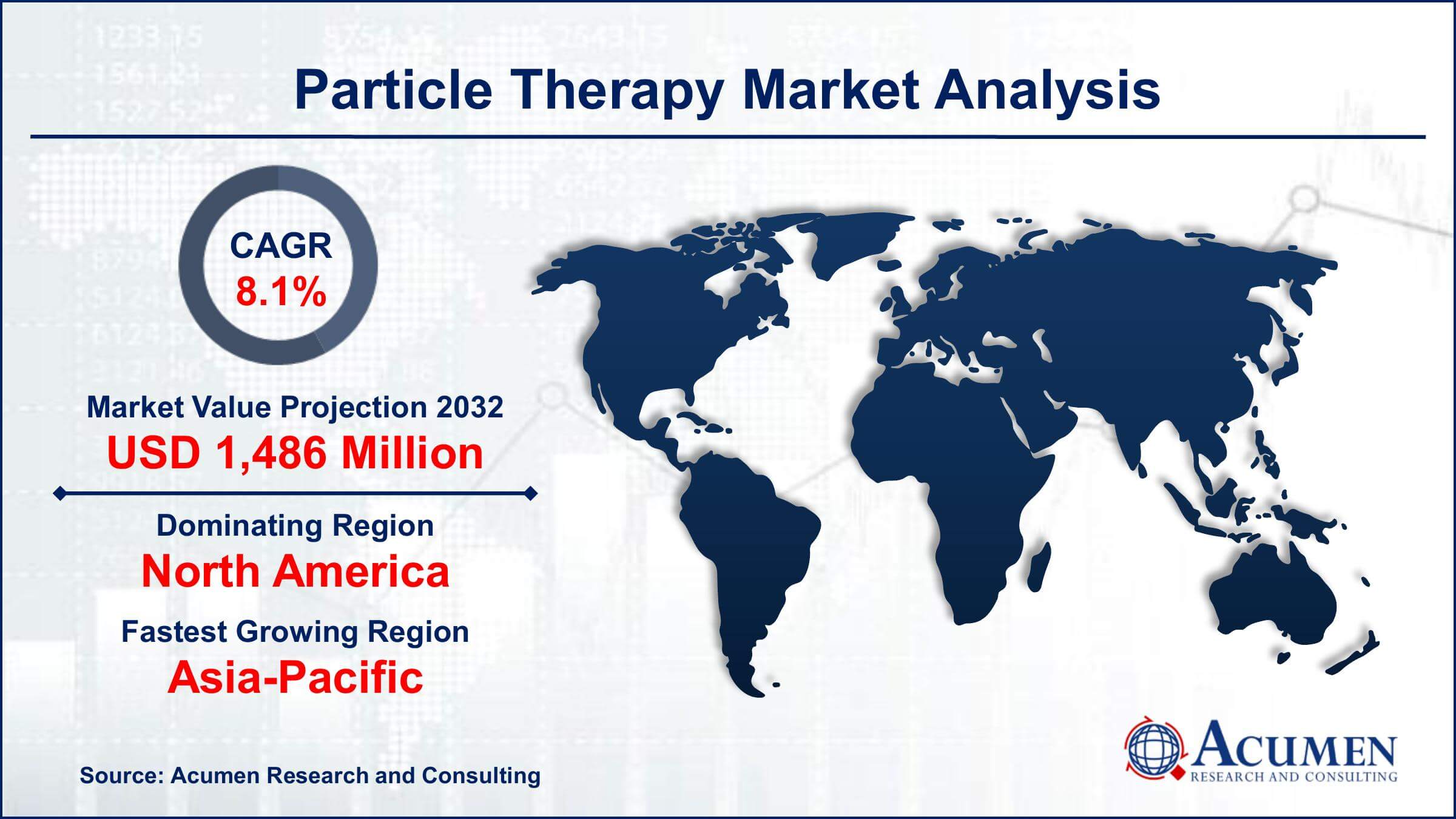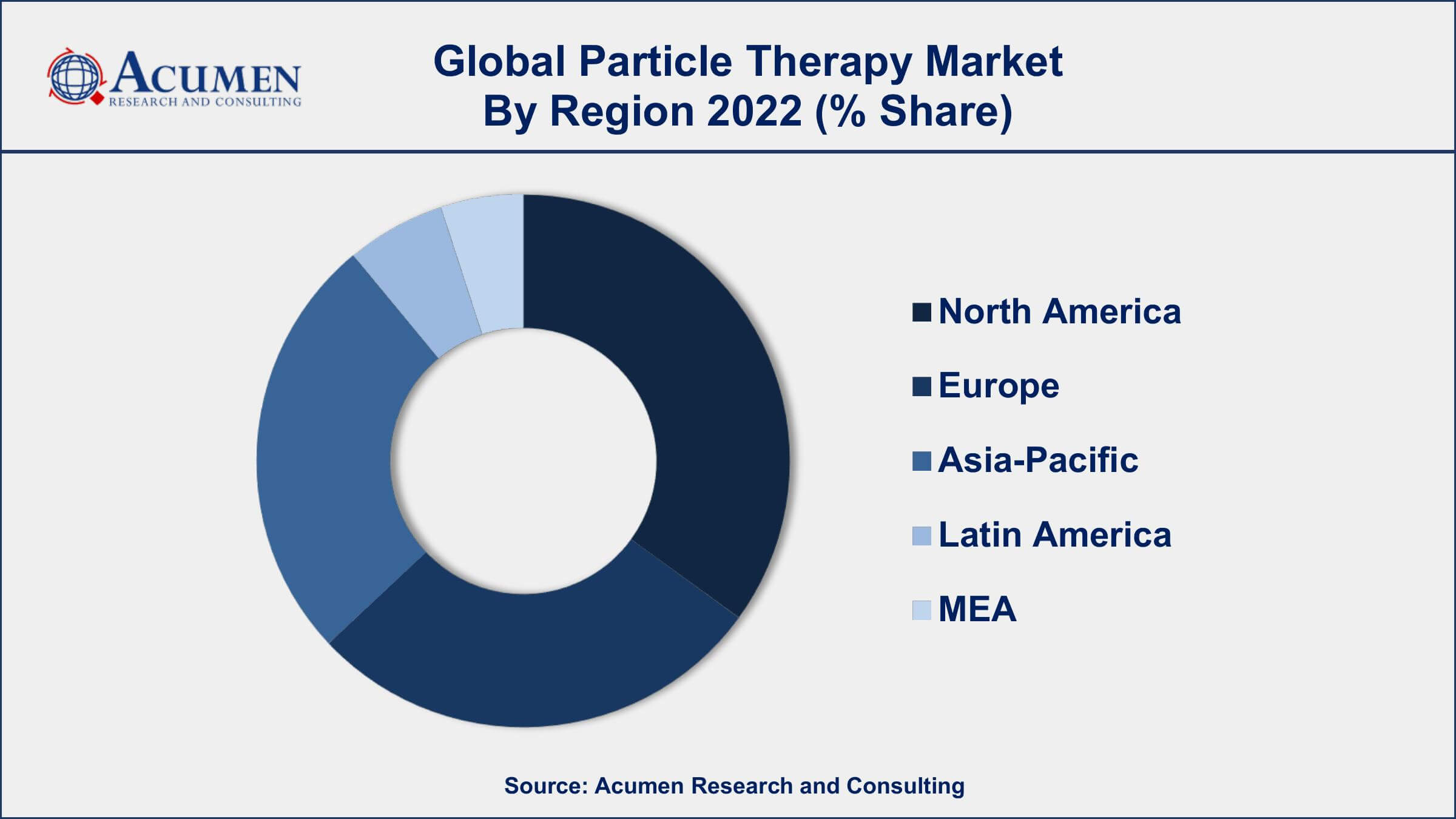Particle Therapy Market | Acumen Research and Consulting
Particle Therapy Market Size - Global Industry, Share, Analysis, Trends and Forecast 2023 - 2032
Published :
Report ID:
Pages :
Format :
The Global Particle Therapy Market Size accounted for USD 693 Million in 2022 and is projected to achieve a market size of USD 1,486 Million by 2032 growing at a CAGR of 8.1% from 2023 to 2032.
Particle Therapy Market Highlights
- Global particle therapy market revenue is expected to increase by USD 1,486 Million by 2032, with a 8.1% CAGR from 2023 to 2032
- North America region led with more than 36% of particle therapy market share in 2022
- Asia-Pacific particle therapy market growth will record a CAGR of around 9% from 2023 to 2032
- The American Society for Radiation Oncology (ASTRO) recommends particle therapy as a treatment option for several types of cancer, including lung cancer, prostate cancer, and head and neck cancer
- By type, the proton therapy segment has generated about 84% of the revenue share in 2022
- Increasing incidence of cancer worldwide, drives the particle therapy market value

Particle therapy is a type of radiation therapy that uses high-energy particles, such as protons or carbon ions, to treat cancer. Unlike traditional radiation therapy, which uses X-rays, particle therapy can more precisely target the tumor while minimizing damage to surrounding healthy tissue. This is because the particles can be directed to stop at the tumor site, delivering a high dose of radiation directly to the cancer cells.
The global particle therapy market has seen significant growth in recent years and is expected to continue to grow at a rapid pace. This is due to several factors, including an increasing incidence of cancer worldwide, a growing demand for more effective cancer treatments with fewer side effects, and technological advancements in particle therapy. In addition, governments around the world are investing in the development of particle therapy facilities, which is driving the growth of the market.

Global Particle Therapy Market Trends
Market Drivers
- Increasing incidence of cancer worldwide
- Growing demand for more effective cancer treatments with fewer side effects
- Technological advancements in particle therapy
- Government investments in particle therapy facilities
- Rising awareness of particle therapy among patients and healthcare professionals
Market Restraints
- High cost of particle therapy equipment and treatment
- Limited availability of particle therapy facilities
Market Opportunities
- Increasing focus on personalized medicine and targeted therapies
- Adoption of artificial intelligence (AI) and machine learning (ML) in particle therapy to improve treatment planning and patient outcomes
Particle Therapy Market Report Coverage
| Market | Particle Therapy Market |
| Particle Therapy Market Size 2022 | USD 693 Million |
| Particle Therapy Market Forecast 2032 | USD 1,486 Million |
| Particle Therapy Market CAGR During 2023 - 2032 | 8.1% |
| Particle Therapy Market Analysis Period | 2020 - 2032 |
| Particle Therapy Market Base Year | 2022 |
| Particle Therapy Market Forecast Data | 2023 - 2032 |
| Segments Covered | By Type, By System, By Application, By Cancer Type, And By Geography |
| Regional Scope | North America, Europe, Asia Pacific, Latin America, and Middle East & Africa |
| Key Companies Profiled | Varian Medical Systems, Inc., Hitachi, Ltd., IBA Worldwide, Sumitomo Heavy Industries, Ltd., Mevion Medical Systems, Inc., ProTom International, Inc., Advanced Oncotherapy PLC, Optivus Proton Therapy, Inc., ProNova Solutions, LLC, snd Particle Therapy Co-Operative Group (PTCOG). |
| Report Coverage |
Market Trends, Drivers, Restraints, Competitive Analysis, Player Profiling, Covid-19 Analysis, Regulation Analysis |
Particle therapy is a type of cancer treatment that uses high-energy particles, such as protons or carbon ions, to target and destroy cancer cells. Unlike traditional radiation therapy, which uses X-rays or gamma rays, particle therapy can deliver a higher dose of radiation to the tumor while minimizing damage to healthy surrounding tissue. Particle therapy can be used to treat a wide range of cancers, including those that are difficult to treat with traditional radiation therapy. It is particularly effective in treating tumors located near critical organs or structures, as it can more precisely target the tumor without damaging surrounding tissue. Particle therapy can also be used in combination with other cancer treatments, such as chemotherapy or surgery. For example, particle therapy can be used to shrink a tumor before surgery, making it easier to remove or to destroy any remaining cancer cells after surgery.
The particle therapy market has been experiencing significant growth in recent years due to various factors. One of the primary drivers is the increasing incidence of cancer worldwide, which has led to a growing demand for more effective cancer treatments with fewer side effects. Particle therapy, with its ability to precisely target cancer cells while sparing healthy tissue, has emerged as a promising option for cancer treatment. Additionally, advancements in particle therapy technology have further propelled market growth, as new systems with improved accuracy and efficiency have been introduced.
Particle Therapy Market Segmentation
The global particle therapy market segmentation is based on type, system, application, cancer type, and geography.
Particle Therapy Market By Type
- Proton Therapy
- Heavy Ion Therapy
According to the particle therapy industry analysis, the proton therapy segment accounted for the largest market share in 2022. This growth is driven by increasing investments in proton therapy facilities and the growing adoption of proton therapy in cancer treatment. Proton therapy is a type of particle therapy that uses protons to treat cancer. It has gained popularity due to its advantages over traditional radiation therapy, including greater precision in targeting cancer cells and lower damage to surrounding healthy tissue. Proton therapy is particularly effective in treating certain types of cancers, such as prostate cancer, lung cancer, and brain tumors.
Particle Therapy Market By System
- Single-Room Systems
- Multi-Room Systems
In terms of systems, the multi-room systems segment is expected to witness significant growth in the coming years. This growth is driven by increasing demand for particle therapy treatments and growing investments in particle therapy facilities. Multi-room systems are particle therapy facilities that feature multiple treatment rooms, which enable healthcare providers to treat more patients and offer a wider range of treatment options. Multi-room systems offer several advantages over single-room systems, including increased patient throughput, reduced wait times for treatment, and greater flexibility in treatment planning. One of the key factors driving the growth of the multi-room systems segment is the increasing adoption of particle therapy as a cancer treatment option.
Particle Therapy Market By Application
- Treatment Application
- Research Application
According to the particle therapy market forecast, the treatment application segment is expected to witness significant growth in the coming years. This growth is driven by increasing demand for particle therapy treatments and the growing adoption of particle therapy in cancer treatment. Treatment application refers to the use of particle therapy to treat different types of cancer and other medical conditions. Particle therapy is particularly effective in treating certain types of cancer, such as prostate cancer, lung cancer, and brain tumors, and has emerged as a promising treatment option for patients who are not suitable for surgery or traditional radiation therapy. One of the key factors driving the growth of the treatment application segment is the increasing prevalence of cancer worldwide. According to the World Health Organization (WHO), cancer is one of the leading causes of death worldwide, accounting for an estimated 9.6 million deaths in 2018.
Particle Therapy Market By Cancer Type
- Pediatric Cancer
- Prostate Cancer
- Lung Cancer
- Breast Cancer
- Brain and Spinal Cord Cancer
- Others
Based on the cancer type, the pediatric cancer segment is expected to continue its growth trajectory in the coming years. This growth is driven by increasing demand for particle therapy treatments for pediatric cancer patients. Pediatric cancer refers to cancer that affects children, and particle therapy has emerged as a promising treatment option for pediatric cancer patients. Children with cancer require specialized treatment that takes into account their unique physiological and developmental needs. Particle therapy offers several advantages over traditional radiation therapy for pediatric cancer patients, including lower radiation exposure to healthy tissue and reduced risk of long-term side effects.
Particle Therapy Market Regional Outlook
North America
- U.S.
- Canada
Europe
- U.K.
- Germany
- France
- Spain
- Rest of Europe
Asia-Pacific
- India
- Japan
- China
- Australia
- South Korea
- Rest of Asia-Pacific
Latin America
- Brazil
- Mexico
- Rest of Latin America
The Middle East & Africa
- South Africa
- GCC Countries
- Rest of the Middle East & Africa (ME&A)

Particle Therapy Market Regional Analysis
North America dominates the particle therapy market due to several factors, including the presence of a large number of particle therapy centers, favorable reimbursement policies, and high healthcare expenditure in the region. The United States is the largest market for particle therapy in North America and accounts for the majority of the revenue generated in the region. The country has a well-established healthcare system and a large population, which has led to the development of a robust particle therapy market. In addition, the favorable reimbursement policies in the United States have encouraged the adoption of particle therapy by healthcare providers. Medicare, the federal health insurance program for people over 65 and those with certain disabilities covers the cost of particle therapy for eligible patients, which has led to increased adoption of particle therapy by healthcare providers in the country. Private insurance companies in the United States also provide coverage for particle therapy, which has further fueled the growth of the market in the region.
Particle Therapy Market Player
Some of the top particle therapy market companies offered in the professional report include Varian Medical Systems, Inc., Hitachi, Ltd., IBA Worldwide, Sumitomo Heavy Industries, Ltd., Mevion Medical Systems, Inc., ProTom International, Inc., Advanced Oncotherapy PLC, Optivus Proton Therapy, Inc., ProNova Solutions, LLC, snd Particle Therapy Co-Operative Group (PTCOG).
Frequently Asked Questions
What was the market size of the global particle therapy in 2022?
The market size of particle therapy was USD 693 Million in 2022.
What is the CAGR of the global particle therapy market from 2023 to 2032?
The CAGR of particle therapy is 8.1% during the analysis period of 2023 to 2032.
Which are the key players in the particle therapy market?
The key players operating in the global market are including Varian Medical Systems, Inc., Hitachi, Ltd., IBA Worldwide, Sumitomo Heavy Industries, Ltd., Mevion Medical Systems, Inc., ProTom International, Inc., Advanced Oncotherapy PLC, Optivus Proton Therapy, Inc., ProNova Solutions, LLC, snd Particle Therapy Co-Operative Group (PTCOG).
Which region dominated the global particle therapy market share?
North America held the dominating position in particle therapy industry during the analysis period of 2023 to 2032.
Which region registered fastest CAGR from 2023 to 2032?
Asia-Pacific region exhibited fastest growing CAGR for market of particle therapy during the analysis period of 2023 to 2032.
What are the current trends and dynamics in the global particle therapy industry?
The current trends and dynamics in the particle therapy industry include increasing incidence of cancer worldwide, growing demand for more effective cancer treatments with fewer side effects, and technological advancements in particle therapy.
Which type held the maximum share in 2022?
The proton therapy type held the maximum share of the particle therapy industry.



